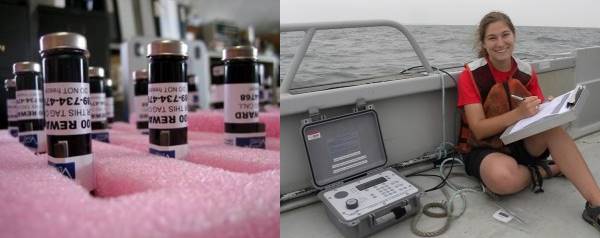Acoustic Telemetry Tracking Technology in Lake Erie Walleye
The benefits of acoustic telemetry tracking technology in fish research have been well-observed in fisheries across the world. The use of acoustic tags has become widely accepted as one of the leading methods for tracking fish movement and behaviors through waterways. Since the method is widely accepted, it’s no surprise that the Ohio Department of Natural Resources (ODNR) uses acoustic telemetry to track their prized walleye stocks in Lake Erie, as well as a variety of other sportfish.
How Acoustic Telemetry Works
Broadly speaking, no matter where acoustic tracking is conducted, the processes are the same. Acoustic telemetry requires fish to have an acoustic tracker implanted into the fish whereinafter the fish is released and consequently observed until the tracker falls off, is removed or no longer transmits recent data due to the fish dying. Immobile tags—tags that are not recording movement due to removal or the fish’s death—are often retrieved and still provide valuable data. For example, it would be important to take note of and consider why a large number of fish in a specific area die. This could point to predation trends, water quality concerns or other variables impacting the life and health of the fish.
The data gathered by these trackers are gathered by receivers spread throughout the waterway or body of water being observed. Scientists say that the trackers in the fish, along with receivers placed throughout Lake Erie and neighboring lakes and streams, act much like systems in place on many U.S. turnpikes to monitor the movements of cars through toll booths. This is because when a fish swims by the receivers, the system basically does the same thing that the toll booth system does with cars, but it instead logs the movement of a living creature—when a fish swims by a receiver, that gets recorded.
The ODNR’s work with walleyes in Lake Erie followed the same process. The study began with researchers implanting acoustic trackers into walleye spawning below a dam located in Ballville Township, just outside of Fremont, Ohio.
The 2016 acoustic telemetry monitoring project relied on students at Stone Lab to help keep the data flowing. The assisting researchers would take kayak trips around the area under study with the equipment that interfaces with the receivers below the water. Frequently checking these devices allowed the data to be downloaded and taken back to the lab for further analysis. After retrieving the data, the receivers below the surface continue gathering data.
With that information in hand, researchers can then combine it with data on each individual fish. The individuals are assessed for age and sex when the transmitters are implanted. The combined data allows researchers to determine where fish go between spawning seasons, whether they return to the same spawning location, or if they spawn every year or take reproductive holidays.

Students in Stone Lab’s Research Experience for Undergraduates Scholarship Program have worked with the Ohio Department of Natural Resources on tracking fish in Lake Erie for about six years. (Credit: Ohio Sea Grant)
Acoustic Telemetry Tracking Applications
Acoustic tags can be used in lakes, streams, rivers, and other aquatic applications. Acoustic telemetry is most commonly used in freshwater environments as the technique requires the fish to swim past a receiver, and marine settings are often considered to be less compatible with the method. However, the method is still used with some saltwater species, like sharks and those that are known to follow migration patterns, like sea turtles. Acoustic tags can also be used in hatcheries and other rearing facilities as a means of tracking fish behavior and habitat preferences.
As acoustic telemetry has grown in popularity, various types of tags have hit the market and been used in various studies. While the tags used in the Lake Erie study were able to receive data whenever the fish was near a receiver, some acoustic tag and receiver combinations are unable to gather data when the tag is below the surface. For example, satellite tags like pop-off satellite archival tags and smart position only tags work best for fish living near the surface as those tags cast data to satellite receivers whenever the fish is at or near the surface.
Underwater applications of acoustic tracking rely on underwater acoustic receivers, which require that researchers go out to the field to retrieve data. In contrast, satellite tag data can be retrieved remotely. Depending on the intended use and resources available, a variety of acoustic tag and receiver combinations may be used to meet research needs.
Conclusion
Researchers from the study state that the data from the ODNR’s acoustic telemetry tracking have been used in refining surgical procedures on walleye. The data gathered was also shared with the Great Lakes Acoustic Telemetry Observation System—a network that helps scientists and others learn more about ongoing acoustic telemetry projects in the Great Lakes—to help further develop acoustic telemetry use in the Great Lakes region.
The greatest contribution of acoustic tracking is how it can help inform management strategies in Lake Erie to ensure that the lake’s walleye and other sportfish flourish. For example, spawning site fidelity—whether fish return to their home stream or reef to spawn—is one important consideration when making management decisions concerning walleye in Lake Erie. For population modeling purposes, the acoustic data help biologists to understand the origin of Lake Erie walleye as well as where they go over the course of their lives.

Pingback: FishSens Magazine | Building Grace: Michigan State UNiversity's Robotic Fish - FishSens Magazine